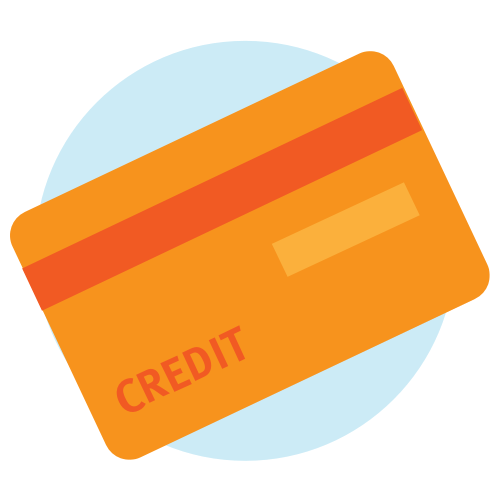
Using Credit Wisely
Credit cards can be an essential tool for borrowing money and managing debt. Introduce your students to using credit cards, understanding credit scores, and managing debt.

Helping Children Build Credit: What You Can Do
There are steps families can take to help their teens build credit. This guide will help families discuss credit use, credit scores, and credit reports with their teens.
Understanding Credit
Prepare your students to handle credit card offers. Use these resources to explain what credit is, how it can impact them, and how to use credit effectively.

Understanding Credit
In this module, students are introduced to the definition of credit along with analyzing the similarities and differences of the three different types of credit people can use - installment credit, revolving credit, and service credit. Throughout the various scenarios explored in the module, students are encouraged to understand the terms of any credit they choose to use in the future.

When to Use or Not Use Credit
Should people use credit? Students consider a variety of issues that show some topics may not have a clear right or wrong answer. In groups, students discuss debt and the use of credit.
Supplemental Resource Links
Types of Credit
This complete unit plan includes lessons, activities, projects, and a case study on credit basics, credit cards, and loans. (To access these resources, you will need to register for a free account and verify that you are an educator.)
Credit Basics
This lesson provides an overview of credit including different sources and types of credit. To help students make decisions about using credit, borrowing is explained as spending future income. (To access these resources, you will need to register for a free account and verify that you are an educator. Once logged in, the link above will take you directly to the resource.)
The Amazing $2,000 Pizza
In this three-minute video, students learn how credit cards work and the importance of using them responsibly.
Deciding When to Use Credit
Help your students explore the benefits and tradeoffs of using credit including the value of building credit over time, ability to build assets through using credit, and comparing credit offers.

Deciding When to Use Credit
In this module, your students will consider when to use credit and when to avoid it. They will explore benefits and tradeoffs including building credit over time and building assets through the use of credit (financing higher education and mortgages). They will also learn how to compare credit offers.
Supplemental Resource Links
Credit Decisions
This four-minute video provides an overview of what loans are, the Five Cs of credit, and what to consider when comparing credit offers.
Easy as Pi
Explore debt-to-income, debt-to-asset, and debt-to-limit ratios with students and strengthen their abilities to make informed borrowing decisions.
Is There Such a Thing as Good Debt?
Share this video with students to learn about the history of debt and borrowing and spark conversations about the use of credit.
Capacity, Character, Collateral, Capital (Credit)
This lesson walks students through the process of getting credit, analyzing good and bad credit, strategies for managing credit, and things that can harm one’s credit. By the end, students should be able to demonstrate their understanding of how credit is earned and possess a greater understanding of the consequences of poorly managing one’s credit.
Get Ready to Borrow Money
With this tool, students explore the 4 C’s of credit (capacity, capital, character, and collateral) and consider how they apply to themselves.
Are You Ready for Your First Credit Card?
This quiz helps students determine whether or not they are ready for a credit card.
Checking Your Credit Report
What is a credit report and how do you know what is in yours? Help your students explore information found in credit reports and show them how to access their credit reports.

Checking Your Credit Report
In this module, ways that young people and adults can check their credit are explained. Students learn what information they can expect to find on a credit report, the steps they should take after obtaining a credit report, and how to limit access to their credit using tools such as credit freezes and fraud alerts.
Supplemental Resource Links
Credit Reports and Scores
In this lesson, students discover what is included in a credit report and recommend strategies for developing a positive credit history. (To access these resources, you will need to register for a free account and verify that you are an educator. Once logged in, the link above will take you directly to the resource.)
Credit Bureaus: The Record Keepers
After reading an article on credit bureaus and how they work, students answer a series of discussion questions. A teacher's guide provides additional resources.
AnnualCreditReport.com
Once students turn 18, they should use this site to request free copies of their credit reports each year. Younger students may preview the site and bookmark it for future use.
How to Use AnnualCreditReport.com
This site explains how to obtain credit reports using the AnnualCreditReport.com website as well as what to look for in the reports.
Improving Your Credit Score
How are credit scores used, and why is having a good one important? After discussing the loan application process, your students will consider their personal prospects for obtaining credit.

Improving Your Credit Score
Your students will explore how lenders judge whether someone will be a good borrower, the components of a credit score, and how they can improve their credit score to get favorable loans on houses and cars in the future.

Who Gets the Loan?
After discussing what they already know about the loan application process, students consider their personal prospects for obtaining credit. Student “loan officers” evaluate the profiles of five individuals seeking car loans and make recommendations about which should receive loans.
Supplemental Resource Links
Credit Scores
This federal government site explains credit scores and how people can work to improve their scores.
Understanding How a FICO Credit Score is Determined
This six-minute video explains how credit scores are calculated and what impacts a person's score.
Credit Score Basics
Students can explore this site for more detailed information on credit scores including credit utilization rates—a concept that confuses many consumers.
Credit Score Video
In this two-minute video, students meet a young entrepreneur who needs to improve his credit to start his business.
Credit Score Estimator
Students can use this estimator to see what their credit score might look like now and in the future. Encourage them to enter different responses to the 10 questions and evaluate how they impact the results.
Credit Clash
Challenge students to battle their way to a perfect credit score in this interactive game. While doing so, they’ll learn what causes credit scores to change. There is also a reflection worksheet that can be used to supplement the game.
Managing Debt
Help your students learn how to manage debt and compare strategies for paying down debt.

Managing Debt
In this module, your students will explore various strategies for paying off debt (lowest balance first vs. highest interest rate first; debt transfer and consolidation), how to avoid scams, and the consequences of poor debt management.

Snowball or Avalanche?
After discussing reasons people find themselves in debt, students work in small groups to learn about two popular debt repayment methods: the snowball and avalanche methods. Students explore two scenarios and discuss why individuals might prefer one method over another.
Supplemental Resource Links
Managing Debt
This site provides an overview of what debt is, strategies to reduce debt, and how to work with debt collectors.
Debt Collection
At this website from the federal government, students can learn about debt collection including the difference between fair and unfair debt collection practices.
Defining Debt Consolidation
In this activity, students collaborate to match questions related to debt consolidation and borrowing with their answers.
Debt Snowball vs. Debt Avalanche: How to Pay Off Your Debt
Students can explore and compare two common strategies for paying down debt.
Debt Diaries
Your students can explore these inspirational stories of people facing—and rising above—their debt management challenges.
